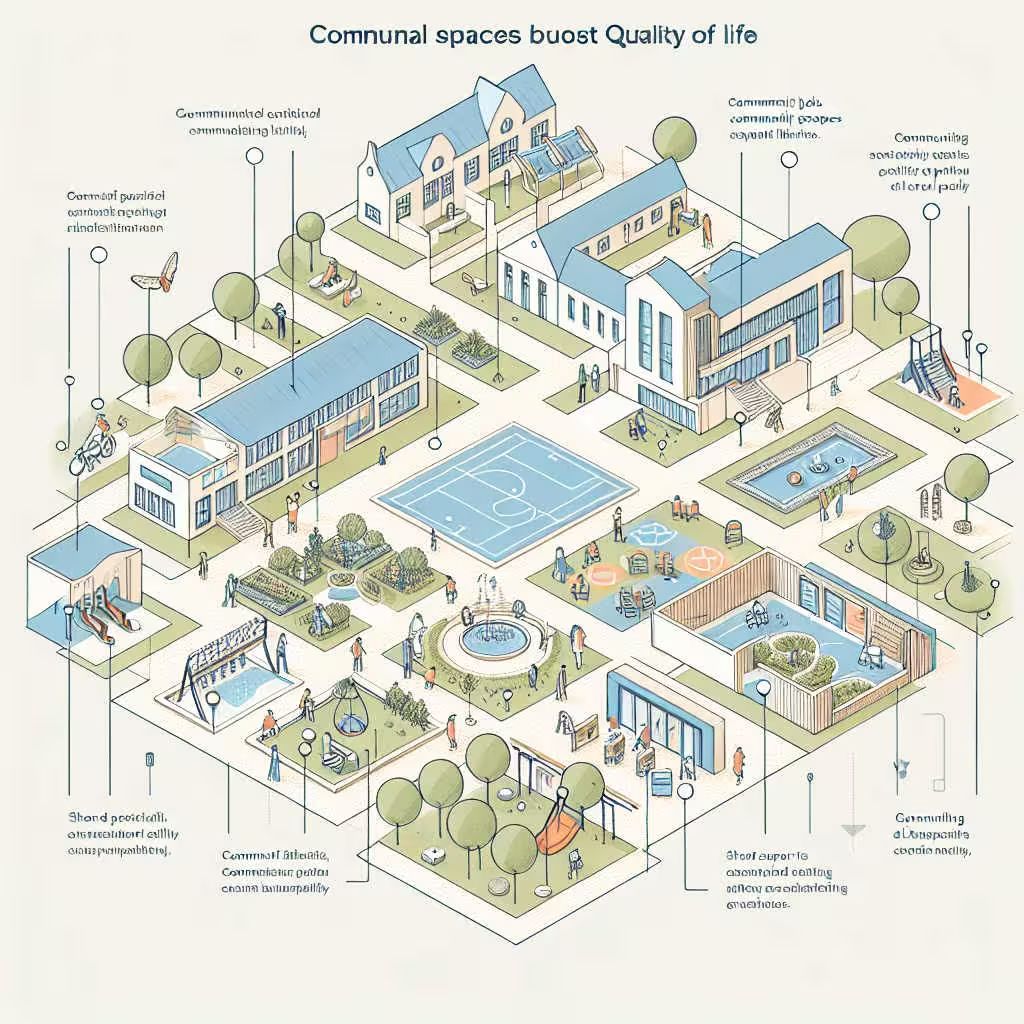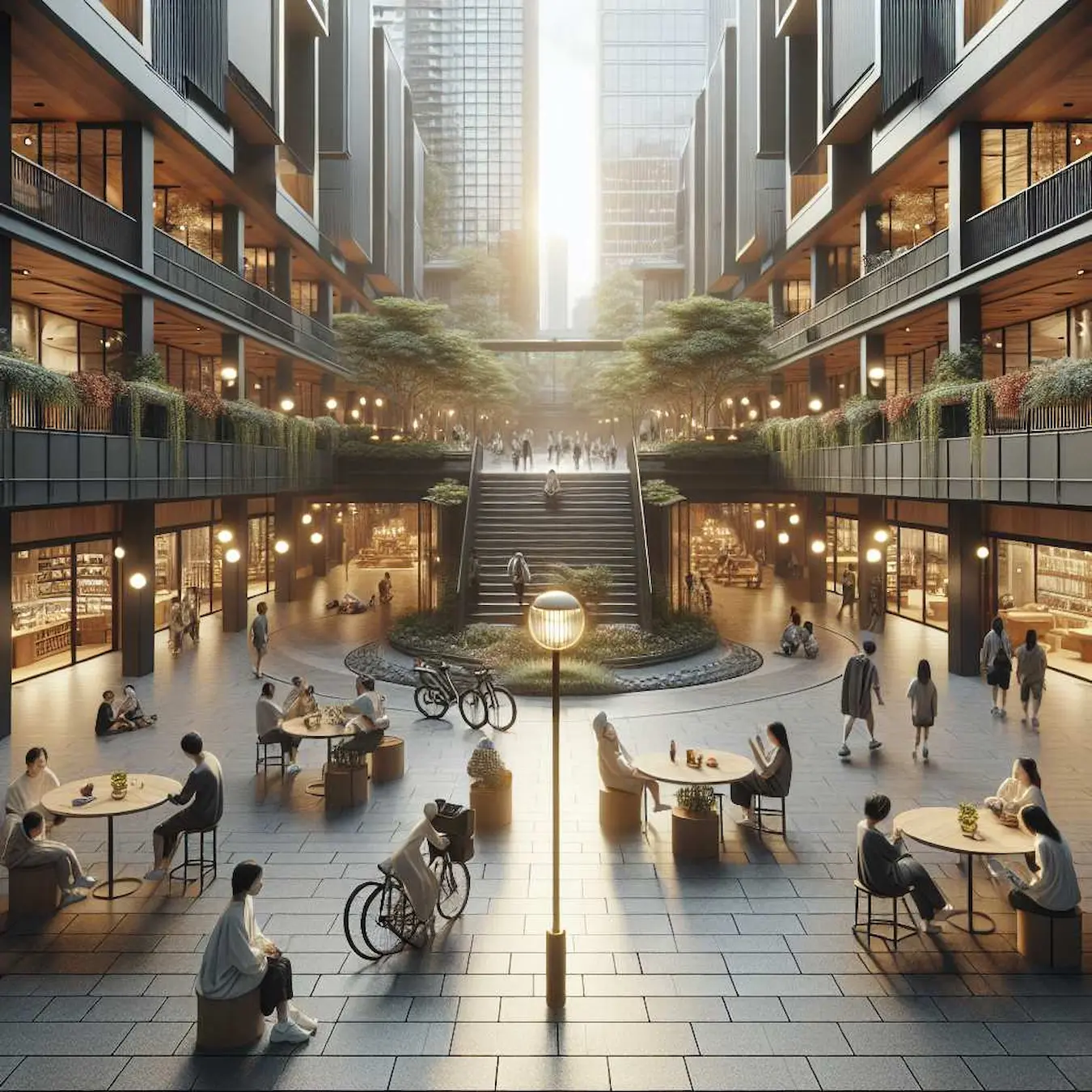At Curvspace, we’re passionate about creating spaces that foster connection and enhance wellbeing. Communal areas play a vital role in shaping our lived experiences, impacting everything from our social interactions to our mental health. As urban environments evolve, understanding how shared spaces contribute to quality of life becomes increasingly crucial. This article explores the multifaceted benefits of communal areas and offers insights into designing spaces that truly enrich our daily lives.
Reader Disclosure
Jump to:
The Power of Shared Spaces
Communal areas serve as the lifeblood of our communities, providing vital hubs for social interaction, relaxation, and personal growth. These spaces come in many forms – from neighborhood parks and community centers to shared lounges in apartment buildings and collaborative workspaces in offices. Each plays a unique role in enhancing our quality of life.
Social Connection and Community Building
One of the most significant benefits of communal areas is their ability to foster social connections. In an increasingly digital world, face-to-face interactions have become more valuable than ever. Shared spaces provide opportunities for spontaneous encounters and planned gatherings alike, helping to combat feelings of isolation and loneliness.
Research has shown that regular social interaction is linked to improved mental health, increased longevity, and a stronger sense of belonging. Communal areas provide the perfect backdrop for these interactions, whether it’s chatting with neighbors in a shared garden or collaborating with colleagues in an office breakout space.
Physical and Mental Wellbeing
Communal areas often incorporate elements that promote physical activity and mental relaxation. Parks and green spaces, for instance, encourage outdoor exercise and provide a respite from urban stress. Studies have found that access to green spaces is associated with reduced rates of obesity, improved cardiovascular health, and better mental well-being.
Even in indoor settings, communal areas can be designed to promote wellbeing. Features like natural lighting, indoor plants, and comfortable seating can create spaces that reduce stress and boost mood. At Curvspace, we prioritize these elements in our designs, recognizing their profound impact on quality of life.

Learning and Personal Growth
Communal spaces often serve as hubs for learning and personal development. Libraries, community centers, and shared workspaces frequently host workshops, classes, and events that provide opportunities for skill-building and knowledge sharing.
These spaces can also foster creativity and innovation through exposure to diverse perspectives. When people from different backgrounds come together in shared spaces, it creates an environment ripe for idea exchange and collaborative problem-solving.
Designing Effective Communal Areas
Creating communal areas that truly enhance quality of life requires thoughtful design. Here are some key principles we follow at Curvspace:
Flexibility and Adaptability
The best communal spaces are those that can adapt to different needs and uses. A well-designed shared area might serve as a quiet reading nook in the morning, a lively social hub in the afternoon, and a venue for community events in the evening.
Inclusivity and Accessibility
Communal areas should be designed with all users in mind. This means considering accessibility for people with disabilities, creating spaces that feel welcoming to diverse age groups and cultures, and ensuring that the area can be comfortably used at different times of day.
Integration of Nature
Incorporating natural elements into communal spaces has been shown to have significant benefits for wellbeing. This could involve creating outdoor green spaces, bringing plants indoors, or using natural materials and color schemes in the design.
Technology Integration
While the primary focus of communal areas is often on face-to-face interaction, thoughtful integration of technology can enhance their functionality. This might include providing Wi-Fi access, incorporating digital displays for community information, or using smart systems for lighting and climate control.
The Impact of Communal Areas on Different Settings
The benefits of well-designed communal areas extend across various settings:
Residential Communities
In apartment buildings and housing developments, communal areas like shared gardens, lounges, and fitness centers can significantly enhance residents’ quality of life. These spaces provide opportunities for neighbors to connect, fostering a sense of community that’s often lacking in urban environments.
Workplaces
The rise of collaborative work styles has highlighted the importance of communal areas in office settings. Breakout spaces, communal kitchens, and informal meeting areas can boost employee satisfaction, creativity, and productivity.
Educational Institutions
In schools and universities, communal areas play a crucial role in supporting learning outside the classroom. Libraries, student unions, and outdoor spaces provide venues for group study, socializing, and extracurricular activities.
Public Spaces
Parks, plazas, and community centers serve as the “living rooms” of our cities, providing essential spaces for recreation, cultural events, and civic engagement. These public communal areas are particularly important for promoting social equity, offering free-to-access spaces that can be enjoyed by all members of the community.
Challenges and Considerations
While the benefits of communal areas are clear, there are challenges to consider in their design and management:
Balancing Privacy and Community
In residential settings, it’s crucial to strike a balance between providing communal spaces and respecting individuals’ need for privacy. This might involve creating a mix of larger gathering spaces and smaller, more intimate areas.
Maintenance and Upkeep
Communal areas require ongoing maintenance to remain attractive and functional. This can be a significant consideration, particularly in public spaces or large residential developments.
Safety and Security
Ensuring that communal areas feel safe for all users is paramount. This might involve considerations around lighting, visibility, and access control, depending on the specific context.
Noise Management
In densely populated areas, managing noise from communal spaces can be a challenge. Design solutions like acoustic treatments and strategic placement of activities can help mitigate this issue.

People Also Ask
How do communal areas improve mental health?
Communal areas provide opportunities for social interaction, which is crucial for mental wellbeing. They also often incorporate elements like green spaces and natural light, which have been shown to reduce stress and improve mood.
What makes a communal space successful?
Successful communal spaces are flexible, inclusive, and responsive to community needs. They should be well-maintained, safe, and designed to encourage interaction while also allowing for moments of solitude.
How can technology enhance communal areas?
Technology can improve communal areas by providing Wi-Fi access, digital information displays, and smart systems for lighting and climate control. It can also facilitate community engagement through apps for booking spaces or organizing events.
Conclusion
Communal areas play a vital role in enhancing our quality of life, fostering social connections, promoting wellbeing, and creating vibrant communities. At Curvspace, we’re committed to designing shared spaces that truly enrich people’s lives. By understanding the multifaceted benefits of communal areas and addressing the challenges in their implementation, we can create environments that support thriving, connected communities. As we continue to shape our built environment, the thoughtful design of communal spaces will be key to creating livable, sustainable cities and neighborhoods.
References
- Kawachi, I., & Berkman, L. F. (2001). Social ties and mental health. Journal of Urban Health, 78(3), 458-467.
- Twohig-Bennett, C., & Jones, A. (2018). The health benefits of the great outdoors: A systematic review and meta-analysis of greenspace exposure and health outcomes. Environmental Research, 166, 628-637.
- Waber, B., Magnolfi, J., & Lindsay, G. (2014). Workspaces that move people. Harvard Business Review, 92(10), 68-77.
Show & Tell
We’d love to hear your thoughts about these ideas! Simply click the link to head over to your favorite platform and add your comments about this post there. We’d like to know about your insights, questions, or just saying hi.
Disclosure
Our content is reader-supported. This means if you click on some of our links, then we may earn a commission. Commissions do not affect our editor’s opinions or evaluations. Learn more about our editorial process.

About the Editorial Staff
The Curvspace editorial team comprises a diverse group of experts on intermediate and threshold spaces in homes and workplaces. Architects and interior designers, civil engineers and artists, environmental and behavioral psychologists, sociologists and anthropologists. All collaborate to create helpful content, that explores the full potential of these often-overlooked areas to enhance our daily lives.


